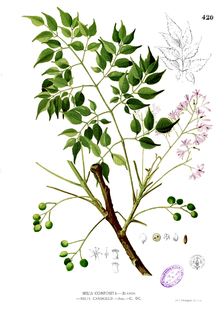Melia (genus)
| Melia | ||||||||
|---|---|---|---|---|---|---|---|---|

Cedar tree ( Melia azedarach ) |
||||||||
| Systematics | ||||||||
|
||||||||
| Scientific name | ||||||||
| Melia | ||||||||
| L. |
Melia is a genus of plants inthe mahogany family (Meliaceae). There are only two species left in the Palaeotropic .
description


Vegetative characteristics
Melia species grow as mostly deciduous trees or shrubs . The freshly grown plant parts are covered with mostly star-shaped and simple hair . Leaf scars and lenticels can be seen on the branches .
The alternate and spirally arranged leaves on the branches are divided into a petiole and a leaf blade. The leaf blades are irregularly pinnate two or three times. The leaflets are petiolate. The edges of the leaflets are toothed to lobed or ± entire.
Generative characteristics
Many flowers are arranged in dichasias in lateral, strongly branched, paniculate or umbrella-like inflorescences . The mostly hermaphroditic or rarely unisexual flowers of Melia species are five or sixfold with a double flower envelope . In the calyx, the calyx lobes overlap like roof tiles. The five or six white or purple-colored petals are linear-spatulate. The ten to twelve stamens are fused into a mostly short cylindrical staminal tube, which is ten or twelve ribs and ends ten or twelve lobes and has a widened opening at the top. The anthers are inserted on the inside of the staminal tube between the staminal tube lobes. The discus is ring-shaped. The three to sechskammerige ovary is almost spherical. Each ovary chamber contains two ovules . The cephalic scar is three to six lobed.
The somewhat fleshy stone fruit from Melia species has a bony endocarp . The seeds are hanging. Endosperm is fleshy, thin, or absent. The seed does not have an aril ( seed coat ). The thin cotyledons ( cotyledons ) are like leaves . The radicle is cylindrical.
Systematics and distribution
The genus Melia was established in 1753 by Carl von Linné with the type species Melia azedarach L. in Species Plantarum , 1, page 384. The genus name Melia is derived from μηλια , the Greek name that Theophrastus (approx. 371 - approx. 287 BC) used for the tree species ash ( Fraxinus ornus ). Linnaeus chose this name because the pinnate leaves and the inflorescences of the leaf axils are similar to the ash. Synonyms for Melia azedarach L. are: Antelaea Gaertn. nom. illeg., Azedarach Mill. nom. illeg., Zederachia Heist. ex manufacture nom. illegal.
Only the two genera Melia and Azadirachta A.Juss. belong to the tribe Melieae in the subfamily Melioideae within the family Meliaceae .
In the genus Melia there are only one, two or three species in the Paleotropic, depending on the author :
- Cedar tree ( Melia azedarach L. , Syn .: Melia azedarach var. Intermedia (Makino) Makino , Melia azedarach var. Subtripinnata Miq. , Melia azedarach var. Toosendan (Siebold & Zucc.) Makino , Melia japonica var. Semperflorens Makino , Melia orientalis M.Roem. , Melia toosendan Siebold & Zucc. ) It is widespread from India over the Himalayas (at altitudes of up to 1800 meters) to Australia and the Solomon Islands . It is cultivated in many areas and is a neophyte in many tropical areas . For example, it is considered an invasive plant species in South Africa .
- Melia volkensii Gürke : It thrives at altitudes of 350 to 1675 meters mainly in deciduous bushland on reddish soils over limestone only in East Africa .
Individual evidence
- ↑ a b c d e f g h i j k l m n o p q r s t u v w Hua Peng, David J. Mabberley: In: Wu Zheng-yi, Peter H. Raven, Deyuan Hong (eds.) : Flora of China , Volume 11 - Oxalidaceae through Aceraceae , Science Press and Missouri Botanical Garden Press, Beijing and St. Louis, 2008, ISBN 978-1-930723-73-3 : Melia Linnaeus. , P. 130 - online with the same text as the printed work.
- ^ Robert E. Preston, Elizabeth McClintock, 2012: Melia. In: Jepson Flora Project (eds.): Jepson eFlora .
- ^ A b c d Michael Heads: Biogeography and ecology in a pantropical family, the Meliaceae. In: Gardens' Bulletin Singapore , Volume 71, Suppl. 2, September 2019, pp. 335-461. doi : 10.26492 / gbs71 (suppl. 2). 2019-22 full text PDF. Melia L. at pp. 387-388.
- ↑ a b c d e MJ Taylor, GJ Harden: Genus Melia at New South Wales Flora online , accessed October 11, 2019.
- ↑ a b c Melia at Tropicos.org. Missouri Botanical Garden, St. Louis, accessed October 11, 2019.
- ↑ Umberto Quattrocchi: CRC World Dictionary of Plant Names , Volume 3 MQ. CRC Press, 2000, ISBN 978-0-8493-2677-6 , p. 1650.
- ↑ Helmut Genaust: Etymological dictionary of botanical plant names. 3rd, completely revised and expanded edition. Nikol, Hamburg 2005, ISBN 3-937872-16-7 , p. 377 (reprint from 1996).
- ↑ a b Alexandra N. Muellner, Rosabelle Samuel, Mark W. Chase, Annette Coleman, Tod F. Stuessy: An Evaluation of Tribes and Generic Relationships in Melioideae (Meliaceae) Based on Nuclear ITS Ribosomal DNA. In: Taxon , Volume 57, Issue 1, 2008, pp. 98-10. doi : 10.2307 / 25065951 JSTOR 25065951
- ↑ Hoe-Won Kim, Seung-Woo Yeon, Ki-Joong Kim: Melia toosendan and M. azadarach are a single species due to their genetic similarity. In: Korean Journal of Plant Taxonomy , Volume 45, March 2015, pp. 36–44. doi : 10.11110 / kjpt.2015.45.1.36